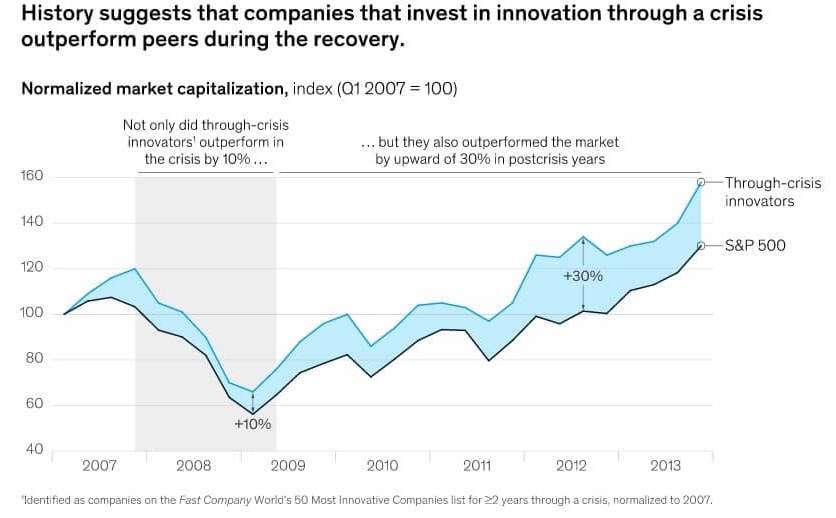In an episode of the Simpsons, Lisa tells Homer: Look on the bright side, Dad. Did you know that the Chinese use the same word for "crisis" as they do for "opportunity"?
This handy trope is not only confined to Springfield; it has been wheeled out by a host of American politicians across the political spectrum, from Hitler sympathiser John Foster Dulles to eco-warrior Al Gore. Regardless of their political inclinations, their message is the same: we can all turn something bad into something good.
While the translation is somewhat off, the spirit of the message is accurate: in uncertain times, it pays to innovate and make bold moves.
Why innovate rather than retreat during a crisis?
Retracting and protecting yourself during a time of crisis is natural. Preserving your cash and minimising risk seem like sensible options. But while these options are understandable, there is a high chance that a lack of business innovation could lead to long-term atrophy.
Arguably, businesses should constantly be innovating; however, innovating in times of crisis is particularly important as the crisis will likely change the landscape and make it impossible to operate as before. Customers and markets change, so doing the following could help address opportunities that did not previously exist.
- Pinpoint areas of opportunity brought about by the crisis
- Understand and adapt to changing customer needs
- Forsee and build postcrisis growth areas
A time of crisis brings with it new market realities, and companies often find that any competitive advantages they once had have changed dramatically.
For example, during the pandemic, many firms that sat and waited for favourable conditions rather than embracing innovation met an ignominious end. But many companies that innovated their business models flourished.
Restaurants increased sales by changing their business model to home deliveries. Sales teams drove growth by moving from in-person to virtual sales. Companies entered new markets by taking advantage of the changing reality—think of the countless medical device companies that emerged. And some tech companies saw the opportunity and just jumped—Zoom lifting its 40-minute paywall limit earned itself a place in the Oxford English Dictionary.
You could argue that Covid-19 was such a particular crisis that it favoured the examples above. However, evidence shows that, after a crisis has ended, innovative companies can perform better than their competition. For instance, Research by McKinsey & Company demonstrates how firms that innovated during the severe global crisis in 2008 outperformed the market average by a third after the crisis. They also had a more substantial growth over the next five years.

Source: McKinsey & Company
Examples of companies that innovated during a crisis
ZeroBounce
ZeroBounce is an email validation company headquartered in Boca Raton, Florida, that launched in 2015. As email databases degrade by around 20% a year, the company removes risky and obsolete data from the databases to improve email marketing ROI.
During the pandemic, ZeroBounce expanded nationally to Santa Barbara, California. This bold move grew the business by almost 1,000% by 2020, and a 56% increase in new customer sign-ups compared with 2019.
In April 2020, ZeroBounce also innovated by adding three new tools to the platform: an email server tester, an inbox placement tester, and a blacklist monitoring tool, which were inspired by the company predicting the effect the Great Resignation would have on email.
Today, the company is listed on Inc. 5000 2022 (a list showing the US’s most successful companies), having grown 308% since 2021.
CrowdStrike
CrowdStrike is a leader in cybersecurity and has created a business model that makes it almost the digital equivalent of toilet paper: recession-proof. Despite companies naturally spending more money on cybersecurity due to digitalisation, CrowdStrike's innovation has helped it stand out from the competition and encouraged its users to spend more money by purchasing more of its modules. By 2021, customers purchasing four or more of its modules had increased by almost 70%.
CrowdStrike expanded internationally to the UK in 2016, which allowed it to offer its innovative products in EMEA markets. This bold move gave the company a global footprint and put it in a position so that during the pandemic, it was able to futureproof itself by making a series of acquisitions.
Adobe
Adobe has been a titan of the software industry for the past 40 years. It has not just weathered past recessions but has grown during crises due to its innovative attitude. Adobe was one of the first companies to switch from selling a physical product to a software-as-a-service (SaaS) model, spurred by the 2008–2009 recession.
During the pandemic, the company also took the opportunity to innovate and rolled out its cloud services for content creation and additional workflow tools based around digital documents, allowing the company to repurchase approximately 3.8 million shares in 2022.
Rathbones
Innovation is not only for tech companies. Rathbones is one of the UK’s oldest and most respected wealth management companies; however, historical financial companies are often not the most digitally advanced companies.
But to grow and stay ahead, in 2019, Rathbones recognised it needed to modernise its technology infrastructure and undertake a digital transformation. Then the pandemic hit. While most companies 'put everything on hold', Rathbones pressed on with its modernisation project, bringing on a new team to innovate, modernise, and drive growth.
Technology and the upcoming 2023 recession
It’s not yet certain that most of the globe will enter into recession in 2023, but it is looking increasingly likely. To combat the gloom, a recent article from The Economist highlights the spirit of innovation in the time of crisis.
It claims that more challenging economic times in 2023 will not prevent companies from investing in innovative technology, specifically tech that helps predict demand, track supply and secure data. In fact, businesses are predicted to increase spending on 2022 levels by 6%, increasing demand for software and its services.
Companies will also look to innovate by using artificial intelligence technology—meaning the market could burgeon to $500bn. They will also continue to invest in cloud computing, which supports decentralised teams and helps collect data. The general trend towards digitalisation will continue, despite the downturn, and this will also induce increased spending on cyber-security tech.
One way to innovate – scale
Business innovation comes in many shapes and sizes—all of which will set your business apart. For example, accelerating will help beat your competition with fast and effective development and launch of innovations. And evolving will help create new business models that provide robust profits. But scaling will take your business to a different level. Ask yourself: are you launching your innovations to the right markets and market segments at the right magnitude?
Scaling through an international expansion strategy will seek future growth opportunities for your business and consider distinct challenges in each market. Adobe, one of the most innovative companies on the planet, is always looking for new markets into which it can expand. During the pandemic, it sought to scale by expanding into developing markets in Latin America and south-east Asia.
However, in Adobe’s words: “Increased opportunity brings increased complexity.
While the opportunities the continued growth in global eCommerce bring are exciting, there are also significant complexities that are impossible to ignore."
Conclusion – scaling safely
Any business innovation is a risk. Yet it is possible to scale boldly whilst reducing the risk and complexities. A Virtual Subsidiary solution can help accelerate your growth plans by enabling you to expand overseas without the cost and risk of a traditional subsidiary company. It should also be able to help run the business compliantly and find and hire the right talent—ensuring they are onboarded, paid, and supported.


